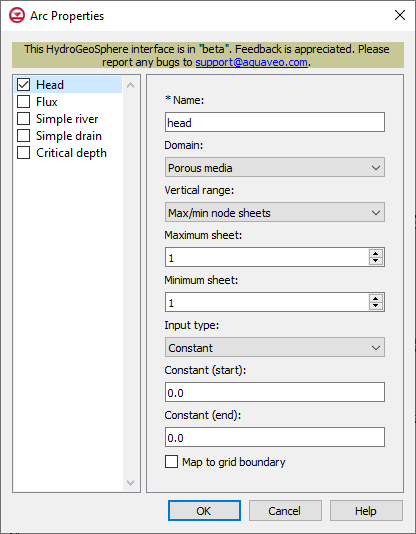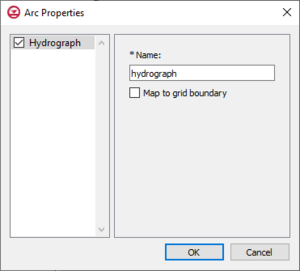GMS:HydroGeoSphere Polygon Properties: Difference between revisions
No edit summary |
|||
| Line 60: | Line 60: | ||
==Related Topics== | ==Related Topics== | ||
* [[GMS:HydroGeoSphere|HydroGeoSphere]] | * [[GMS:HydroGeoSphere|HydroGeoSphere]] | ||
* [[GMS: | * [[GMS:HydroGeoSphere Coverages|HydroGeoSphere Coverages]] | ||
{{Navbox GMS}} | {{Navbox GMS}} | ||
[[Category:HydroGeoSphere|Poly]] | [[Category:HydroGeoSphere|Poly]] | ||
Revision as of 17:13, 27 February 2024
The Polygon Properties dialog is where the parameters for a polygon in a boundary conditions or hydrograph coverage are defined in a HydroGeoSphere model. Only one type of boundary condition can be assigned to a feature object on a boundary conditions coverage. For hydrograph coverages, "Hydrograph" is the only option available to assign to a feature object.
Head or Flux, Boundary Conditions Coverage
Head and flux are two separate available arc property types on a boundary conditions coverage, but the input options available are the same. Head is a general specified head boundary condition, and flux is a general specified flux boundary condition. The input options for head and flux are listed below.
- Name – Enter a name for the arc.
- Domain – The domain in which the boundary condition is applied.
- "Porous media" – Set properties for porous media.
- Minimum sheet – Boundary conditions will be applied between the minimum and maximum node sheets.
- Maximum sheet – Boundary conditions will be applied between the minimum and maximum node sheets.
- Input type – How the boundary condition data is specified.
- "Constant"
- Constant (start) – Constant value of the boundary condition at the start of the arc.
- Constant (end) – Constant value of the boundary condition at the end of the arc.
- "Time series"
- Time series (start) – Time-varying values of the boundary condition at the start of the arc.
- Time series (end) – Time-varying values of the boundary condition at the end of the arc.
- Interpolate – Causes time-varying values to be interpolated, resulting in a smoother application of the time-varying function.
- Map to grid boundary – Map boundary condition to the boundary of the grid (not the interior).
- "Constant"
- "Surface flow" – Set properties for surface flow.
- Input type – How the boundary condition data is specified.
- "Constant"
- Constant (start) – Constant value of the boundary condition at the start of the arc.
- Constant (end) – Constant value of the boundary condition at the end of the arc.
- Map to grid boundary – Map boundary condition to the boundary of the grid (not the interior).
- "Time series"
- Time series (start) – Time-varying values of the boundary condition at the start of the arc.
- Time series (end) – Time-varying values of the boundary condition at the end of the arc.
- Interpolate – Causes time-varying values to be interpolated, resulting in a smoother application of the time-varying function.
- Map to grid boundary – Map boundary condition to the boundary of the grid (not the interior).
- "Constant"
- Input type – How the boundary condition data is specified.
- "Porous media" – Set properties for porous media.
Simple River or Simple Drain, Boundary Conditions Coverage
Simple river and simple drain are two separate available arc property types on a boundary conditions coverage, but the input options available are the same. Simple river is a river flux drainage boundary condition, and simple drain is a drain flux drainage boundary condition. The input options for simple river and simple drain are listed below.
- Name – Enter a name for the arc.
- Input type – How the boundary condition data is specified.
- "Constant"
- Constant (start) – Constant value of the boundary condition at the start of the arc.
- Constant (end) – Constant value of the boundary condition at the end of the arc.
- Map to grid boundary – Map boundary condition to the boundary of the grid (not the interior).
- "Time series"
- Time series (start) – Time-varying values of the boundary condition at the start of the arc.
- Time series (end) – Time-varying values of the boundary condition at the end of the arc.
- Interpolate – Causes time-varying values to be interpolated, resulting in a smoother application of the time-varying function.
- Map to grid boundary – Map boundary condition to the boundary of the grid (not the interior).
- "Constant"
Critical Depth, Boundary Conditions Coverage
The critical depth boundary condition determines the rate at which mass is leaving the model domain.
- Name
- Transient – Define a time value table to turn the boundary condition on and off. Values of -99999 indicate that the BC is turned off.
- Time series – Time value table. Values of -99999 indicate that the BC is turned off.
- Map to grid boundary – Map boundary condition to the boundary of the grid (not the interior).
Hydrograph, Hydrograph Coverage
Assigning "hydrograph" to an arc on a hydrograph coverage in a HydroGeoSphere model allows GMS to record hydrograph data during the model run. This requires that "Hydrograph" is set as the parameter for an arc HydroGeoSphere hydrograph coverage, which is done inside the Arc Properties dialog. The coverage then needs to be added to the simulation. Upon the simulation run, GMS will output detailed flow rate information at each time step for each arc that has been assigned a hydrograph.
- Name – A descriptive name for the hydrograph, which can be up to 80 characters.
- Map to grid boundary – Map grid to the boundary of the grid, not the interior.
Related Topics
GMS – Groundwater Modeling System | ||
|---|---|---|
| Modules: | 2D Grid • 2D Mesh • 2D Scatter Point • 3D Grid • 3D Mesh • 3D Scatter Point • Boreholes • GIS • Map • Solid • TINs • UGrids | |
| Models: | FEFLOW • FEMWATER • HydroGeoSphere • MODAEM • MODFLOW • MODPATH • mod-PATH3DU • MT3DMS • MT3D-USGS • PEST • PHT3D • RT3D • SEAM3D • SEAWAT • SEEP2D • T-PROGS • ZONEBUDGET | |
| Aquaveo | ||

